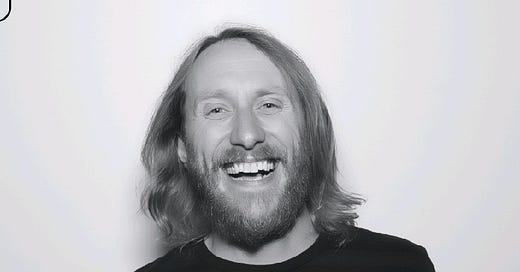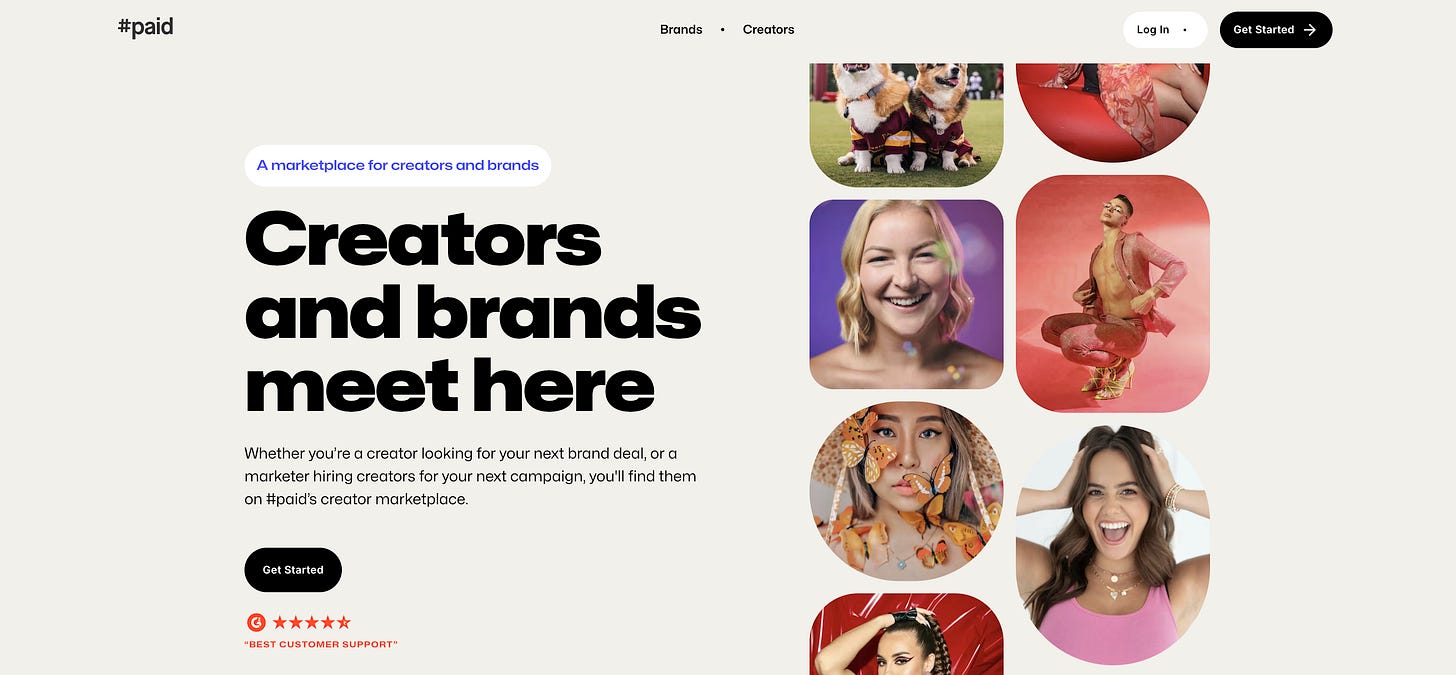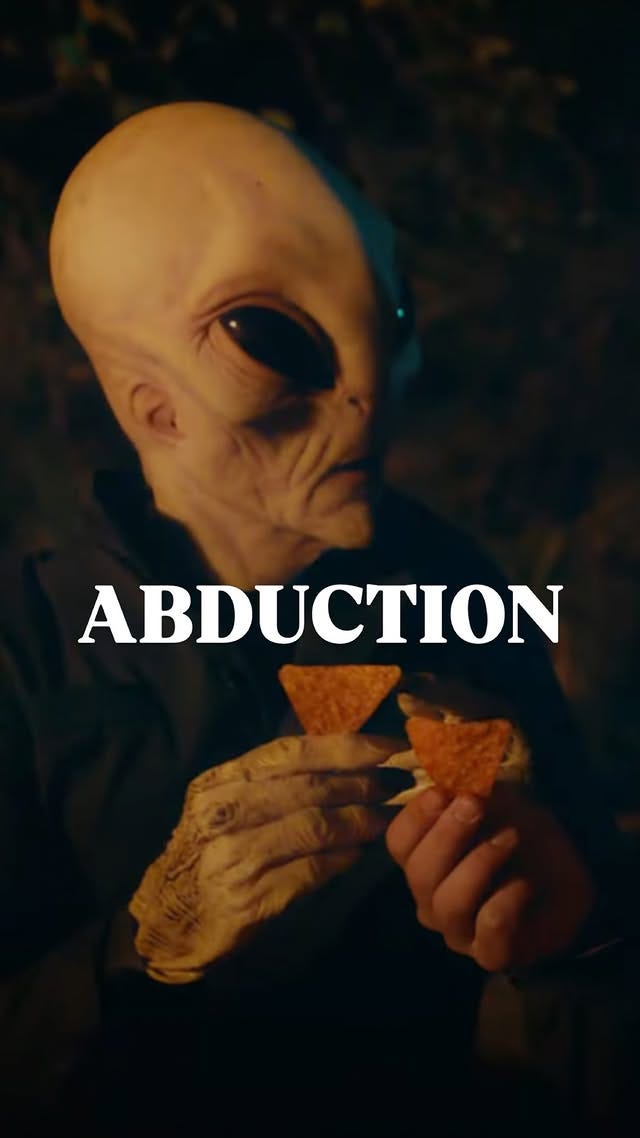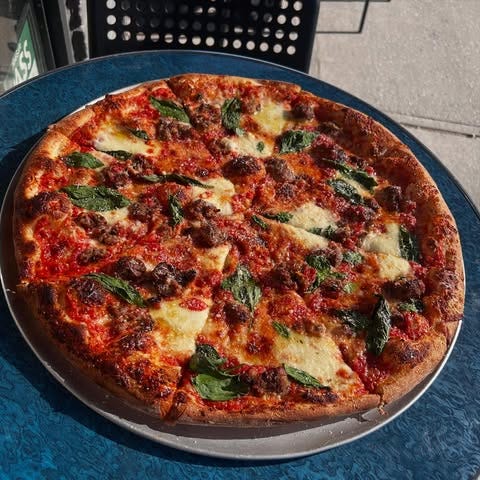Power of creator emotion (mixed with data)
Creator Conversation with Dylan Dunstall, Associate Client Partner at #paid
Welcome to “Creator Conversations,” a weekly feature on Paid Partnership where I interview a prominent creator, agent, marketer or industry professional to discuss wide-ranging topics from outreach to negotiation to content.
“Hey Neil, I’ll be in New York we should grab lunch.”
While I do love a free meal (my leftover Chinese lunch staring back at me as a type), I responded quickly and sorted the above email into a “networking” folder alongside many other sales-adjacent messages.
Fast forward ~3 years, that simple lunch has sparked an online connection extending well beyond the walls of creator marketing into verticals such as hardcore music, skateboarding and more.
Hello, Dylan Dunstall.
Dylan is on the Client team at #paid, a creator marketing agency and marketplace, that’s among some of the top players in the space.
Dylan’s passion for the industry is palpable and combined with his extensive knowledge about his platform, clients, and creators, he’s defining how some of the top brands across the globe approach their creator strategy.
Dylan jumped on our top-secret, encrypted, international video call to share wisdom on:
Benefits of a creator marketplace
Favorite collaboration of all-time
Creator marketing trend reports
And more!
Neil: I've always been a bit dubious of creator marketplaces, if for no other reason than I feel like creators struggle to answer email or text, let alone log on to a different platform to utilize a different service. How do you approach educating the creator and/or agent about your platform?
Dylan: I totally hear you on that. I see it like this: it's not about limiting a creator’s ability to check their phone or manage a marketplace. It’s about doing big, exciting marketing with a lot of different brands. Every brand and creator works differently—I know that because I work with tons of both. What we can do as a marketplace, or an extension of your team, is this: we standardize the way you interact with us and the way creators engage with us. That allows us to build accountability.
For example, if a creator isn’t responding to their email, we don’t go back to square one. We don’t have to start over with a new creator and rebuild the relationship. Since I have a network, I can plug someone else in quickly. Plus, we have accountability built in. If something goes wrong, we know who the reliable creators are and who isn’t trustworthy. We vet them upfront, so we don’t put unreliable creators in front of clients like the NBA.
The flip side is that my team doesn’t want to waste time replacing creators. That’s why we do all the vetting and onboarding ahead of time. By the time you see a creator, you won’t need to worry about monitoring their day-to-day actions. If needed, we can do a background check, especially in a restricted industry. But you won’t have to worry about things like, "Does this creator have an OnlyFans account I don’t know about?" All the checks and balances are already in place. You can focus on milestones and touchpoints, not constant hand-holding and basic instructions.
Neil: Tell the non babysitting portion to my creators that are FaceTiming me at 11pm on Sunday [laughter, jokes].
Dylan: We love it. I always tell people, creators are amazing at so many things, but we often forget—they’re creatives. Creatives aren’t always MBA types. Marketers are more likely to have MBAs; creators are more likely thinking, "Did I leave the stove on?" because they’re focused on their art. So how do we help them succeed by adding business acumen? At a certain point, they don’t negotiate their own deals; they hire talent agents for specialized expertise. We have PR agencies for PR, creator agencies for creators—we don’t ask them to cross over.
Neil: I think an interesting portion of your first answer is that your marketplace is operating somewhat like a talent management service. So naturally, correct me if I'm wrong, you're not repping these creators directly. However, you are doing some sort of vetting, background, multiple deals where you're operating somewhat like talent management.
Dylan: If you picture it on a spectrum, agencies are on one end, tech platforms are over on the other, and we site somewhere right in the middle. You’re right, man. We have customers who use us just for sourcing creators and providing organic content based on their briefs. In that case, we’re hands-off—they just need the assets for their paid media. On the other hand, we have customers who treat us as an extension of their team, whether they’re an agency or a brand, because they don’t have the capacity or expertise to handle creator media and licensing. By working with us, we become that extension and offer more hands-on support, especially if they don’t have the headcount to manage the full process.
Neil: I've talked about discovery a lot over the past two months here on this platform, so you're confident in both the tech and the human side to serve a brand, finding the perfect creator for a campaign?
Dylan: It’s funny because creator marketing is still so young. I’ve been with #paid for almost four years now, and what I see time and time again is that print media, like Conde Nast, has been doing this for over 100 years. The creator marketing industry, on the other hand, is maybe 10 years old—still figuring things out. Everyone’s trying to figure out how it works. The best way we’ve learned is by doing something, hitting a bump, and then figuring out how to correct it.
What we’ve found is that the more work we do upfront with creators—like onboarding them to our platform and doing brand safety checks before a brand even shows interest—it helps prevent issues down the line. So with discovery, we don’t just wait for creators to sign up. We go out and understand who they are, where they are in life, and make sure we’re not passive about it. For example, if a creator signs up with us, we don’t just wait for them to be picked. Our Talent Team goes out and finds the right fit, even if the creator isn’t already in our network.
Take, for example, the conversation we had about Hardlore a while ago. We can go out, do the vetting, negotiate, and onboard creators like that too, so it’s a simple plug-and-play for you, just like any other #paid creator.
A lot of brands struggle with this. I had a conversation a year or two ago with someone from a major American airport. She asked for airplane creators. And I thought, "I can think of maybe one guy who fits that, @airplanefactswithmax, but other than that, what even is an airplane creator?" What she really wanted was creators who had a travel story with an emotional connection to an airport. We helped her realize that instead of focusing on the technical aspects of flying, she needed to tell a story—like the mom who’s going on a delayed honeymoon, stressed about leaving her baby behind. That emotional connection was the story that would resonate. It's not just about finding an "airplane creator"—it’s about finding the right story.
It’s like the Henry Ford quote: if I had asked people what they wanted, they would have said "faster horses." You need to go beyond what’s asked for and understand the deeper connection.
Neil: Write that down, get that tattooed.
I speak with a lot of agency folks like yourself, whether that's for a partnership, just as colleagues, networking, etc. - There's so many movers in the creator economy right now, so curious as to where you see you and your company fitting in and what might set you apart.
Dylan: It’s like the Nike vs. Adidas debate—50% of people will say Nike, 50% will say Adidas. Ultimately, it’s personal preference. Creator marketing is the same way—it’s a crowded space, especially in 2025. Almost every company is doing something well, but it’s about what you value and where you’re headed.
Where I see #paid as a front-runner is for brands that want to be leaders in the industry, not just those looking to rinse and repeat with nano creators, UGC, or D2C. For example, some brands want airplane creators, while others want that emotional honeymoon story. We excel at this because we brought in one of Snapchat’s former head strategists as our VP of Strategy. Everything we do is data-driven and based on industry trends.
If you’re a brand just catching up with creator marketing, you don’t want to spend the next few years testing and falling behind. Instead, we focus on where the industry is headed, build emotional connections with audiences through data-backed strategies, and create a roster that’s approved on the first round—avoiding bottlenecks. And when things go wrong, because marketing is always unpredictable, you want a partner who’s in the trenches with you, not someone who’s maxed out on their retainer and asks if you want to top up.
To distill it down, we’re about doing big, exciting things. If you’re just looking for easy, rinse-and-repeat content, we’re not the right fit. It’s all about the service and the talent network. All our creators are onboarded and vetted. Unlike many of our competitors, who are just search tools with millions of influencers in their network, we don’t scrape data from the internet. With #paid, we have speed to market, so if you need to turn around a summer campaign, we can get it done the first time, no problem.
Neil: Going back to the data portion, I've talked to a lot of agency colleagues about this recently. How are you approaching your reporting and ROI, particularly when the goal might just be social engagement and not a conversion?
Dylan: Yeah, right from the start, when I talk to a marketer who’s not well-versed in this, it’s a lot of education. You get it, Neil—you’re ahead of the pack. But sometimes an old school brand marketer will say, "Dylan, I want to see ROI, and I want the contract to say if we don’t hit our ROI goal, I don’t pay you." And I’m like, that’s not how business works, we can’t ask a creator to work for free and hope they make rent this month, but I love the confidence.
It all comes down to whether we’re measuring the right things. For example, if we’re running an awareness campaign, we can’t expect immediate ROI. We had a customer who went through a few team changes mid-campaign and lost sight of the fact that it was an awareness campaign. They were surprised they didn’t get conversions on their $5,000 "click to buy" ad. But we both know that’s not how it works—it’s a funnel, and you’ve got to work through it.
For brands, it’s about stepping back and asking: Am I measuring the right thing from the start, or am I trying to cheat by jumping straight to the bottom of the funnel? From there, you need to ask if your campaign is designed to drive toward your objective. For example, awareness campaigns don’t drive immediate conversions. Awareness just gets the product in front of people so they’re familiar with it. There’s a huge difference between telling someone to "grab a Coke next time you’re in the store" and "click here to buy a pallet of Coke."
Also, when building these campaigns, have we thought about things like pixel access for tracking? Are we calibrating so we can follow the sales process, or are we just tracking the landing page and not knowing what happens next?
About a year ago, we brought in the woman who built Reddit’s measurement suite to build ours. We realized that to be taken seriously, we have to open up the "black box" of creator marketing, just like any other channel. You can’t go to the CEO and say, "Hey, we spent $200,000, and here are some likes and vibes." You need to be able to say, "Here’s what happened, here’s why, and here’s how we can make it even better next time."
One way we do this is through Brand Lift studies. We go beyond just asking, "Do you remember seeing this ad?" We ask, "What did you like about it? How did it make you feel?" Maybe it’s not about Coca-Cola itself, but because there were puppies in the ad, and people love puppies. (Bad example, but you get the point.) This is why working with a data-driven agency like #paid is so important. We can provide you with concrete insights—this is what your audience likes, this is what they don’t.
It’s not about anecdotal guesses like, "These were 6.1, these were 9.6." It’s real data: "This is what people remembered, and this is why they liked it." That way, you can take those insights and apply them to the next campaign, feeding the data machine like a wood chipper, constantly improving.
Neil: Favorite collaboration you’ve worked on?
Dylan: Oh, gosh. Okay, so my favorite project we’re working on—I can’t name names yet, but it’s in the gaming industry. Gaming and RMG brands have such a huge white space right now, especially with things like the legalization of sports betting and online casinos. This is a newer market, and there’s so much potential for brands to step up and lead. It’s like, if you’re a beauty marketer, you’re fighting L’Oreal, Unilever—those giants. But with gaming, it’s the wild west of creator marketing, and we’re right there at the frontier, which is super exciting.
Now, one I can name—though you may have heard me mention it before—is the project we did with Infiniti. Instead of just creating content for Instagram that fades away, they had the creator film a full-on car commercial—an ASMR-style video. The whole concept was about the quietness of the Infiniti car. We worked with an architectural photographer (not your typical car ad person) who’s also an official photographer for F1. The commercial follows him hunting for perfect shots around Toronto, showcasing how the car offers a place of solace amidst the city’s noise. The performance was amazing—so good, in fact, that Infiniti bought the rights to run it in Air Canada headsets before flights and at Cineplex movie theaters in Canada. This is a huge benefit of working with #paid: because we have display partners, you’re just paying a standardized usage fee. That way, you get maximum value out of the content without having to pay up front for something you haven’t even seen perform.
Another cool project we did was with Doritos for the Super Bowl. We had a bunch of creators shoot content that was then merged into a commercial for their "Crash the Super Bowl" campaign. What made this so special was getting real creators—not celebrities or pseudo-celebrities—into one of the biggest sports events of the year. Seeing those creators on that stage, instead of traditional stars, was a huge win.
Neil: Favorite creator marketing trend of 2025?
Dylan: For me, it’s storytelling. I know that sounds generic, but over the last six months to a year, marketers are finally starting to understand that creator marketing isn’t about just throwing a pseudo-celebrity into an ad. It’s about stepping back and asking the creator, "Why are you doing this?" For example, if I’m a home renovation retailer, instead of just promoting the latest cordless drill, I want to know why someone is renovating their house. Maybe they’re moving because they just got married, and now they need to create a dream home for their new blended family. That’s the real story we want to tell, bringing the audience on that journey.
The product itself—like a drill that drives more screws in less time—just doesn’t connect with people anymore. It’s 2025; we all know marketers are going to hype up a product. What matters is creating an emotional connection. We’re more likely to buy Nikes, even though they’re more expensive, because we connect with the brand.
What excites me is seeing creators who really get it—creators who are confident enough to set boundaries and say, "This is my voice, and if we’re going to work together, it needs to stay true to that." Even more exciting is seeing marketers finally understand that this approach gets better results. They’re realizing that they need to trust the creator as the expert on creative, just as they trust themselves as the expert on their brand.
Neil: Trend that you would like to see go away?
Dylan: A lot of people still think about creator marketing like it worked five years ago. What I’d like to see go away are those rigid, product-first approaches. Tell a story and weave the product into it, rather than forcing it in. I’d also like to see brands stop jumping on trends that their audience isn’t asking for. For example, if you're a power drill company, does it make sense to do an ice bucket challenge, or are you just blending in with everyone else? You’re not standing out.
What I really want to see is brands trusting creators in the creative process. When push comes to shove, does it really matter if the text is in white at the bottom instead of black, or if it’s on the left side instead of the right? It’s still in the safe area, so why not give some control to the creators? Let them maintain their tone of voice, instead of being overly prescriptive with the content. You know what I mean?
Neil: Favorite Toronto restaurant?
Dylan: Oh man, I’ve got to shout out Mac’s Pizza. I know I’m talking to a New Yorker, so don’t shoot me, but it’s hands down the best pizza in Toronto. I’ll die on that hill. It’s on Bloor Street, and the owner is amazing. If you're ever in Toronto, I’ll gladly take you there—it’s the best slice you’ll have outside of New York, north of the border.
Neil: Last one - Can you do a kickflip?
Dylan: Dude, no, I’m serious. I don’t know if you saw my LinkedIn headline, but I’m actually the world’s worst skateboarder. I can’t kickflip, can’t grind—I’m really just happy riding up and down halfpipes. At my mid-30s, I’m too old to keep challenging myself in that area. So, I’ve hit my skill cap, and I’m not ashamed of it. Plus, no broken bones, so I’ll take that as a win.








